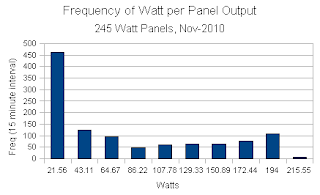It is very difficult to determine what size panels and inverter to get. One option is to slightly oversize your panel wattage output compared to your inverter capacity. For example, installing 20 panels of 235 kW gives you a theoretical maximum of 4.7kW output from the panels. Installing a 4 kW inverter means your panels are over-sized for the inverter by 18%. I have heard that solar installers often will "oversize" the panel array for the inverter by 10%-20%. The logic is that you can save a little money by buying a smaller inverter because the likelihood of the system frequently producing maximum power is low. Also, inverters are often most efficient when operating towards their top end of output. Therefore, installing an over powered inverter means it may be operating at less than its maximum efficiency - and that is an power conversion loss to you.
Another reason why panels will be over-sized is for people installing a 10 kW array. The microFIT program limits you to 10 kW of either panels or inverter, whichever is the lowest rated output. Therefore, the system would install 10% or more watts of panels of the inverter capacity - to maximize the amount of energy generation in the mornings, afternoons, and cloudy days. You pay a little more for the panels, but in the long run you make more power under suboptimal radiation periods. And the project would still qualify as a =<10 kW project for the microFIT rules.
My situation was a little different. At first I was going to have 20 235 W panels, however, I eventually had 20 245 W panels installed, and I had a 4 kW inverter. Instead of my panel array being over-sized by 18% it was now 23%. I had no reliable way to assess if I would have a significant power generation loss over the year with an inverter that could now be notably undersized. Additionally, when I ran the Fronius
configuration tool [
online version] my panel voltages were now going to exceed the inverter optimal ranges under certain temperature regimes. My solar installing company graciously switched my inverter to a 5 kW Fronius IG 5100. My inverter is now a little over-sized for my 4.9 kW system, but I am pleased that I'll not be losing power generation during peak radiation periods.
So... during a relatively cloudy, cool November, how much energy do my panels produce? I downloaded the entire month, except today's data [a very dark rainy day] and calculated the per panel 15 minute average power generation in watts.
Some stats:
- there were 1103 15-minute measurement intervals from 1-29 Nov [will be higher in the summer when the sun is up longer]
- the cloudy mornings, afternoons, and other very dark periods meant that quite often the average panel output was less than 21.5 W [that's less than 10% of the panel capacity]
- maximum output was 215.5 W, there were only 7 15 minute periods where power was greater than 194 watts
- maximum total output was 4311 W, this is somewhat low as higher values have been recorded in August and September
I'll publish similar results for the forthcoming months.

